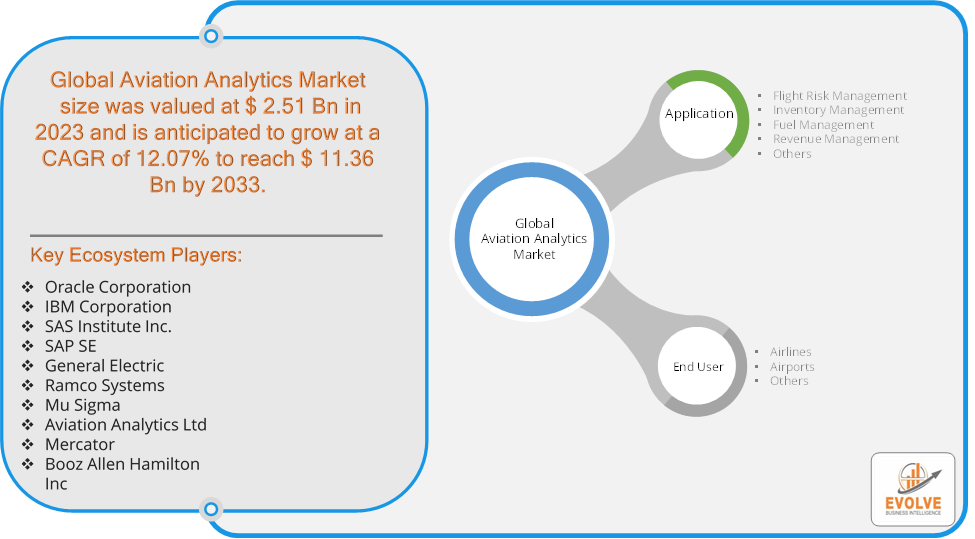Aviation Analytics Market Estimated to Record 12.07% CAGR During Forecast Period
Evolve Business Intelligence has published a research report on the Global Aviation Analytics Market, 2023–2033. The global Aviation Analytics Market is projected to exhibit a CAGR of around 12.07% during the forecast period of 2023 to 2033.
Evolve Business Intelligence has recognized the following companies as the key players in the global Aviation Analytics Market: Oracle Corporation, IBM Corporation, SAS Institute Inc., SAP SE, General Electric, Ramco Systems, Mu Sigma, Aviation Analytics Ltd, Mercator and Booz Allen Hamilton Inc.
 More Information: https://evolvebi.com/report/aviation-analytics-market-analysis/
More Information: https://evolvebi.com/report/aviation-analytics-market-analysis/
Market Highlights
The Global Aviation Analytics Market is projected to be valued at USD 11.36 Billion by 2033, recording a CAGR of around 12.07% during the forecast period. The Aviation Analytics Market refers to the segment within the aviation industry that involves the collection, analysis, and interpretation of data to enhance operational efficiency, safety, and decision-making. This market includes a wide range of analytics solutions and services designed to optimize various aspects of aviation operations, including flight operations, maintenance, fuel management, customer experience, and financial performance.
The Aviation Analytics Market plays a crucial role in modernizing the aviation industry, driving efficiency, safety, and enhancing the passenger experience through data-driven decision-making.
The COVID-19 pandemic had a significant impact on the Aviation Analytics Market. The pandemic led to a drastic reduction in both domestic and international flights due to travel restrictions, lockdowns, and a decline in passenger confidence. This reduced the volume of data generated from flights, affecting data-driven analytics activities. The pandemic increased the emphasis on health and safety measures. Aviation analytics were used to monitor and ensure compliance with new health protocols, track the spread of the virus, and manage passenger health data. The unpredictable nature of travel demand during the pandemic made predictive analytics crucial for demand forecasting. Airlines used analytics to predict and adapt to fluctuating passenger numbers and travel patterns. The pandemic accelerated the adoption of digital technologies in the aviation industry. Analytics solutions, along with AI and machine learning, played a pivotal role in enabling this transformation. The pandemic has highlighted the importance of sustainability. Airlines and airports are likely to use analytics to support sustainable practices, such as reducing carbon emissions and optimizing fuel efficiency.
Segmental Analysis
The global Aviation Analytics Market has been segmented based on Application and End User.
Based on Application, the Aviation Analytics Market is segmented into Flight Risk Management, Inventory Management, Fuel Management, Revenue Management and Others. The Fuel Management segment is anticipated to dominate the market.
Based on End User, the global Aviation Analytics Market has been divided into Airlines, Airports and Others. The Airlines segment is anticipated to dominate the market.
More Information: https://evolvebi.com/report/aviation-analytics-market-analysis/
Regional Analysis
The Aviation Analytics Market is divided into five regions: North America, Europe, Asia-Pacific, South America, and the Middle East, & Africa. North America, particularly the United States and Canada, has a well-established aviation infrastructure and a high adoption rate of advanced technologies. The presence of major airlines, airports, and technology companies drives the demand for aviation analytics solutions. There is a strong focus on innovation and R&D, leading to the early adoption of cutting-edge analytics solutions, including AI and machine learning. Europe has a mature aviation market with a high level of technological adoption, especially in countries like the UK, Germany, and France. European airlines and airports are increasingly focusing on sustainability, using analytics to reduce carbon emissions and improve fuel efficiency. Enhancing passenger experience through personalized services and efficient operations is a key driver for analytics adoption in Europe. The Asia-Pacific region is experiencing rapid growth in air travel, driven by increasing disposable incomes, urbanization, and expanding middle class. Significant investments in airport infrastructure and new airline routes are driving the demand for analytics to manage growing passenger volumes and improve efficiency. Countries like China, India, Japan, and Singapore are increasingly adopting advanced analytics solutions to enhance operational efficiency and customer experience. The Middle East, particularly countries like the UAE and Saudi Arabia, is investing heavily in aviation infrastructure, creating opportunities for analytics solutions to optimize operations and manage large-scale airports. Airlines in the Middle East are known for their focus on luxury and high-quality service, using analytics to personalize and enhance the passenger experience. The Latin America region is witnessing growth in air travel, driven by economic development and increasing tourism. Airlines and airports are focusing on improving operational efficiency and reducing costs through analytics solutions.

